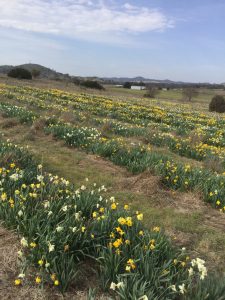
In an otherwise unprepossessing paddock near Yass in New South Wales, Lawrence Trevanion is doing beautiful and technically fascinating things with daffodils.
Where the beauty is concerned you don’t have to take my word for it. Have a look at his website at www.trevaniondaffodils.com.au/
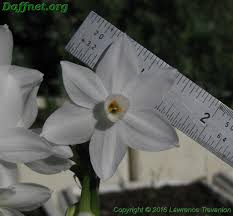
Although too modest to mention it himself, Lawrence has an international reputation as a daffodil breeder. He has twice been a guest speaker at meetings of the American Daffodil Society.
Lawrence’s international reputation is associated with Narcissus bulbocodium, the petticoat or hoop-petticoat daffodil.
Currently his renown is growing due to his work on breeding with the green N. viridiflorus. He reports that “the very fertile N. viriquilla shows that the intersectional jonquilla hybrids are compatible with the intersectional viridiflorus hybrids”.
He is acknowledged in the American Daffodil Society’s Daffseek database as a pioneer breeder with N. elegans, a native of countries in the western Mediterranean. It has an orange corona and is sweetly scented. It grows in ‘bunches’ rather than as a solitary flower, and the leaves and flowers appear at the same time.

The paddock in which Lawrence undertakes what seems to be a labour of love is thickly grassed in a good year, with scattered eucalyptus trees and scrubby groundcover. It has the appearance of an unkempt sheep paddock, with kangaroo trails testament to their presence and their practised peregrinations. There is a small dam, full nearly to the brim when we visit him in late September.
Among the apparent normal grazing order is evidence of Lawrence’s detailed scientific – especially botanical – mind, applied over thousands of hours with patience, understanding and humility to the propagation of daffodils.
He works at the micro – and almost say microscopic – level, using tweezers to effect fertilisation between two selected cultivars.
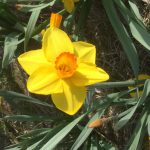
People have been working at daffodil (or narcissus) hybridisation for well over a hundred years. There are over 30,000 named hybrids in the official register. But, like so much else in the natural world, it’s not a simple matter. The more one digs, the more complex it seems to be.
"It is generally acknowledged that the genus Narcissus presents great taxonomic problems, and there have been numerous attempts at its classification. Some authors have taken a very wide view of the concept of each species (e.g., Webb, 1980), resulting in as few as 26 recognised species, while some (e.g., Fernandes 1969b) have taken a very narrow view which results in the recognition of a great many species (upwards of 60), often involving a complex hierarchy of infraspecific taxa.""Most of the groups – most frequently referred to as sections – are fairly obvious, for example the Trumpet daffodils, the Tazettas, the Pheasant's eyes, the Hoop Petticoats, the Jonquils, and so on, and these are the basic divisions in the genus recognised here." "An additional complication to the taxonomy is posed by hybridisation. Most species of Narcissus will hybridise but, significantly, there is great variation in the fertility of the offspring, depending upon the degree of relationship between the parents. - - There has been a great deal of hybridisation in this very popular, garden-worthy genus, resulting in thousands of hybrid cultivars and selections (Kington, 1998), and doubtless this will continue. Although much of this work has been concerned with sophisticated selection for flower form and colour (e.g., pink and red coronas and apricot-coloured perianth segments), there are probably still some interesting lines of research that could be pursued using the many wild species. Taking just one possibility as an example, the autumn-flowering species (Narcissus serotinus, N. elegans and the green-flowered N. viridiflorus) could perhaps be utilised in the production of a race of larger-flowered autumnal narcissi, thus extending the overall flowering season of the garden forms by several months. With the great diversity of characters exhibited by the species and their numerous variants, there are great possibilities in this natural gene pool. However, some of the species are under threat in the wild, and many more will become so with increasing urban and tourist-based development." [From the chapter by Brian Mathew, in Narcissus and Daffodil - The genus Narcissus, edited by Gordon R. Hanks, Horticulture Research International, Kirton, UK, Taylor & Francis e-library, 2005.]
On our visit Lawrence talks about his work with patience and good-humour, answering our questions with a chuckle, making it clear that more detail can be provided if we’re game.
If only one had listened more carefully at school or followed up on the biology lessons when it came time for genetics. If only one had a chart of the taxonomic hierarchy for Narcissus.
The story of how Lawrence became interested in the breeding and cultivation of daffodils is rich in emotion and deserving of poetry (or a good feature film) rather than mere prose.
As a youth walking through the bush near Bombala he was struck by finding daffodils which had been planted by early settlers a century or more before, the sole remnants of long gone bush houses and gardens. The apparently fragile yellow forms were still prospering where palings, brick footings, out-houses and other human-induced infrastructure had disappeared from view as a town became a village, a village a memory.
It’s as if daffodil bulbs and seed are possessed of more of the resilience needed to mark for future generations the places in which their forebears lived, loved and planted than those generations themselves.
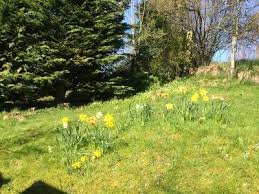
He started collecting and exhibiting daffodils in Western Australia in the 90s. He moved to southern NSW as a scientist who, to use his own expression, “has spent a lifetime trying to avoid a career”.
Facebook confirms that Lawrence is known chiefly as a breeder of miniatures, particularly hoop petticoats. Another admiring visitor to Lawrence’s Elysian Field has posted:
"Row after row of standards, including doubles and splits, greeted us. An extraordinary collection of triandrus and jonquilla/fernandesii hybrids also took my eye, in yellows, whites, pinks, and combinations of each of them, including reverse bicolours."
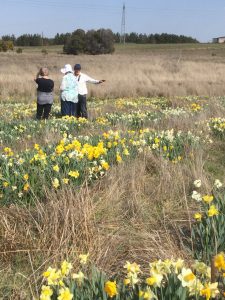
"As a former high school teacher in maths and science with a particular interest in biology, Lawrence was the 'full bottle' on the latest theories of genetic inheritance, breeding strategies and what-to-cross-with-what. The apparent fertility of triploids was due to their producing diploid gametes, he said. He aimed to produce small or miniature offspring which were both tetraploid and interfertile. Looking up from his contemplation of the seedling beds, into the distance, he complained about the local cockatoos and kangaroos."They're pests", he said. "The cockatoos pick the flowers and throw them on the ground, and the roos jump on them.""
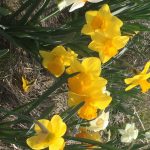
Our initial connection with Lawrence and Jane was through the Woden Valley Youth Choir. Jane was for several years President of the WVYC Committee, with Lawrence the ever-present supporter, backroom assistant and (I seem to recall) photographer for special occasions. Since their daughter left the choir our relationship has become yellower, more daffodil. And what a delight that is.
I look forward to visiting the daffodils again next year. Lawrence – with Jane’s support – will describe the seasonal variation to which his variegated flock has been subject. He will crop us a bunch. He will answer the bigger and simple questions with patience, all over again; because I will have forgotten, and he will again seed his explanations with as much science as I can accommodate.
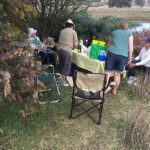

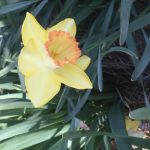
test
check